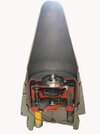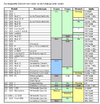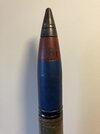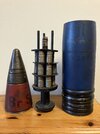Years ago i picked up a WWII era German artillery fuse with the stamped identity " Z30 Kurz " on it along with other marking that was roll marked on the fuse so was not necessarily easily readable. The most information I ever found anywhere was from the sellers description of the fuse, and there is not a great deal of information elsewhere. It fits into a thread the size of which is tapped into the 8.8cm flak round fuse hole. The fuse resembles the typical aluminum standard Z30 timer anti aircraft flak fuse, but is made of steel, and is much heavier than the aluminum Z30 timer fuse. At the nose of the fuse there is just a little green paint or lacquer that the nose had been dipped into or was sprayed on at the time it was made, but it has worn off mostly. It's a translucent type of paint film, more like it was a greenish dyed lacquer than a pigment.
When i got it, the write up on it said that there were many 8.8cm projectile types, and this fuse was used on a type of projectile that was packed with submunitions arrayed in tiers within the interior space of the shell, and the design was intended to burst i suppose, and scatter these submunitions over a radial area and explode.
i do know that the United States has 155mm shells that are designed to do exactly this function, and the base of the shell comes off and maybe from the spin of the driver band scatters 88 submunitions roughly the size of the black plastic 35mm photography film containers all around, but the American weapon is used for striking at ground threats, the German projectile was certainly used to destroy allied bombers dropping their bombs on German cities.
I've included a photo of the fuse, the roll marked identity of the fuse is as clear as I could make it with my limited knowlege of image enhancement tools. The most odd thing about this piece is that I have never heard of such a shell being used in the German arsenal, so i tend to think ths type of shell was one of many varieties of shells used by the Germans, but it was either so difficult to build each shell, or the idea never produced an effect that was as destructive as the military had hoped the design would be on aircraft t was tested on.
If anyone does know of any information about this fuse and it's possible use by the Germans in WWII, please reply with whatever information you know of.
Thanks
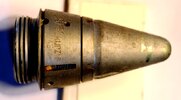
When i got it, the write up on it said that there were many 8.8cm projectile types, and this fuse was used on a type of projectile that was packed with submunitions arrayed in tiers within the interior space of the shell, and the design was intended to burst i suppose, and scatter these submunitions over a radial area and explode.
i do know that the United States has 155mm shells that are designed to do exactly this function, and the base of the shell comes off and maybe from the spin of the driver band scatters 88 submunitions roughly the size of the black plastic 35mm photography film containers all around, but the American weapon is used for striking at ground threats, the German projectile was certainly used to destroy allied bombers dropping their bombs on German cities.
I've included a photo of the fuse, the roll marked identity of the fuse is as clear as I could make it with my limited knowlege of image enhancement tools. The most odd thing about this piece is that I have never heard of such a shell being used in the German arsenal, so i tend to think ths type of shell was one of many varieties of shells used by the Germans, but it was either so difficult to build each shell, or the idea never produced an effect that was as destructive as the military had hoped the design would be on aircraft t was tested on.
If anyone does know of any information about this fuse and it's possible use by the Germans in WWII, please reply with whatever information you know of.
Thanks


